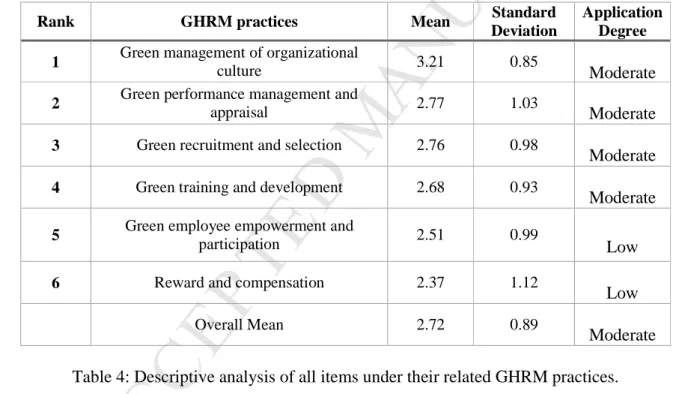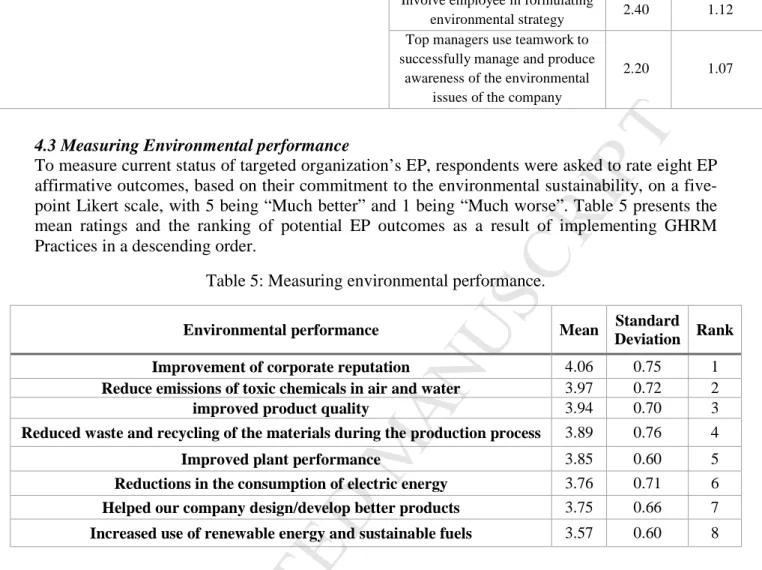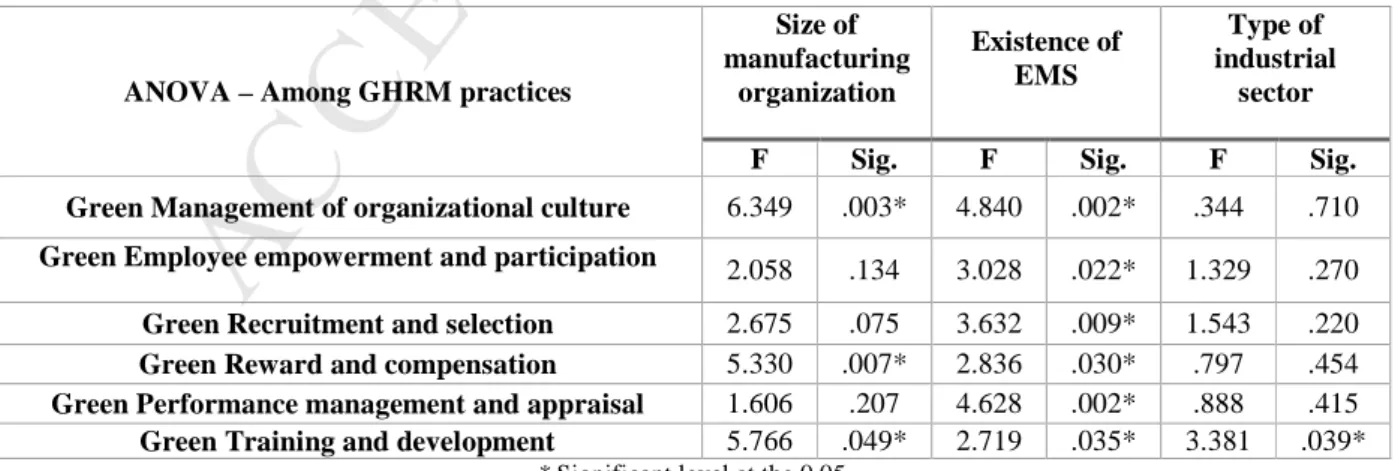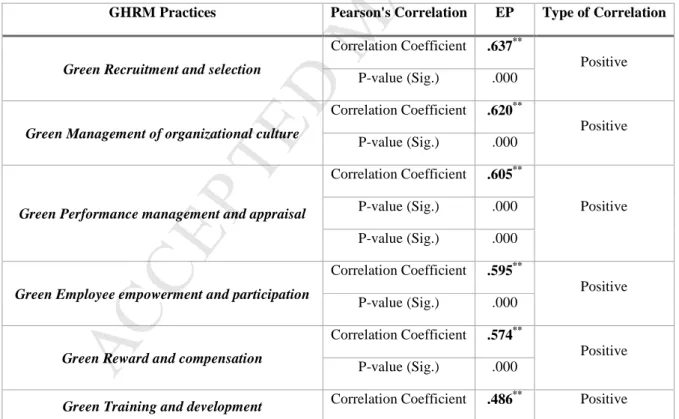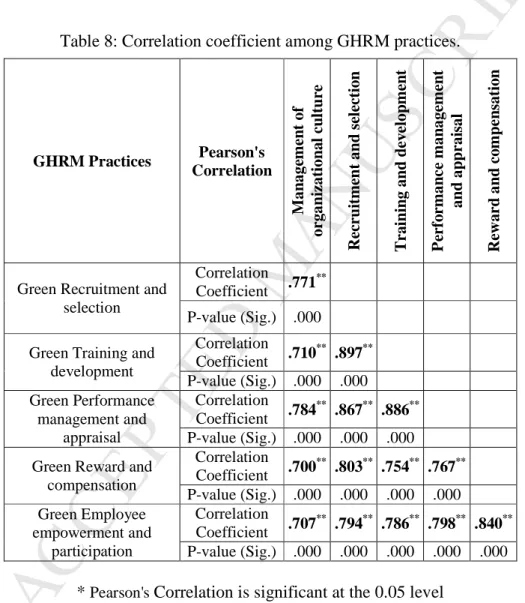The situation in the occupied Palestinian territories is unique in that the Israeli authorities dominate Palestinian internal environmental policies (Görlach et al., 2011). Since then, studies on HRM have become increasingly common, encouraging new empirical studies on the subject (Renwick et al., 2013). At the same time, GHRM is part of a wider corporate social responsibility program (Sathyapriya et al., 2013).
Organizations must focus on selecting and hiring an employee who supports and is interested in the environment (Renwick et al., 2013). According to Harvey et al. 2013), improving organizational mechanisms for employee empowerment and participation in the workplace enables the voice of employees to be heard to help shape environmental goals. On the other hand, top management should define sanctions for violating environmental regulations and rules (Renwick et al., 2008; Mandip; 2012).
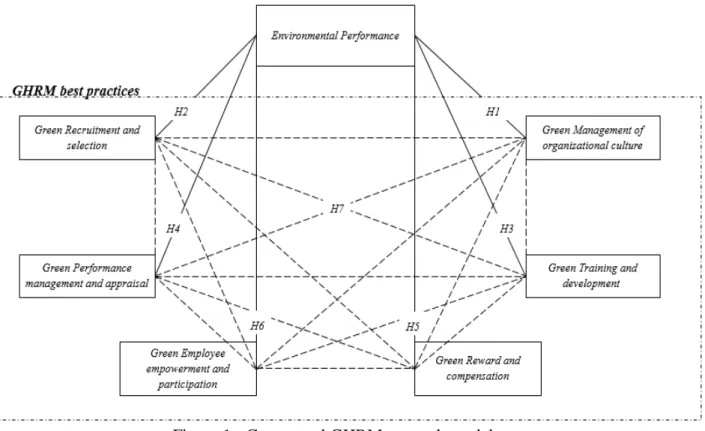
Research methodology
The study population consists of manufacturing organizations from three manufacturing industrial sectors (i.e. food, chemical and pharmaceutical manufacturers) operating in the West Bank region of the OPT, where the majority of Palestinian manufacturing organizations are located. This is in line with the cautionary recommendations by Mohtar and Rajiani (2016) for the selection of production organizations from the areas where they are most located. The Palestinian Federation of Industries was contacted to obtain clear information regarding the names, details and numbers of valid registered manufacturing organizations.
However, in order to identify and then target only manufacturing organizations implementing GHRM initiatives, the researchers directly contacted each organization's HR manager, or senior HR personnel in some cases, through a phone call to inquire about availability. of all or some of the GHRM practices in the country. before sending the survey electronically. The same procedure enabled the identification of potential candidates for the semi-structured interviews mentioned above. Of the available 130 manufacturing organizations, 110 organizations (64 from food, 42 from chemicals, and 4 from pharmaceutical manufacturers) expressed the availability of some or all GHRM practices and agreed to participate in the study.
For this purpose, data was collected over a period of eight weeks through an online survey that was sent by e-mail to HR managers in all those organizations that agreed to participate in the research. An online survey provided easy and relatively quick data collection (Creswell, 2004). However, of the 110 targeted manufacturing organizations implementing GHRM practices, the total number of usable returned surveys was only 90; representing a response rate of 81.81%. Respondents for the survey instrument had to rate each item on a five-point Likert scale (1-not at all, 2-to a lesser extent, 3-to a moderate extent, 4-to a large extent, 5-to a very large extent).
This assessment made it possible to identify the extent of the use of GHRM practices in their respective manufacturing organizations (Roy and Khastagir, 2016). The level of GHRM practices in an organization was assessed based on the mean ratings of the measurement items for each measure.
Data analysis and results
Profile analysis shows that 79% of the respondents from the target manufacturing organizations are male while only 21% are female. The application of the level of application concept reflects the level of implementation of GHRM practices in the studied manufacturing organizations. As already mentioned, the respondents for the survey instrument had to rate each survey item on a five-point Likert scale (1-not at all, 2-to a lesser extent, 3-to a moderate extent, 4-To a great extent, 5-To a very great extent ).
This section examines the availability of potential significant differences in GHRM practices attributable to the control variables of manufacturing organizations' size, existence of EMS, and the type of industry sector. The analysis of the relationships between the GHRM practices and the three control variables was done using the bivariate analysis and developed using one-way ANOVA test; which allows the comparison of more than two independent groups. Regarding the size of the manufacturing organizations, respondents' answers were divided according to size (measured by the number of employees) into three groups based on OECD standards and classifications (OECD, 2005).
While there are statistical differences between three sizes of organizations in the degree of application of the GHRM practices of "green management of organizational culture", "green reward and compensation", and "green training and development" where (P-value < 0.05) . According to the existence of EMS at the targeted manufacturing organizations, Table 6 shows that there is a statistical difference in the degree of application of all the GHRM practices (P-value < 0.05). For all GHRM practices when comparing 1) EMS currently exists, 2) has plan to implement within 12 months, 3) has plan to implement in more than 12 months, and 4) has no plans to implement, are there differences in favor of "EMS currently exists".
Furthermore, Table 6 by industry sector shows that there are no statistical differences among the three industrial sectors of the organizations (i.e. food, chemical and pharmaceutical) in the level of use of any of the GHRM where (P value > 0.05) except for. Showing the correlation of the study variables was necessary to assess the correlation between EP and the six identified GHRM practices. Furthermore, it should be noted that GHRM practices positively correlate with EP in descending order; green recruitment and selection (ρ=0.637), green performance management and appraisal (ρ=0.620), green organizational culture management (ρ=0.605), green employee empowerment and participation (ρ=0.595), green reward and compensation (ρ= 0.574 ) and green training and development (ρ=0.486).
These correlations can be described as positively strong, as all the Pearson correlation coefficients are above ρ=0.5.
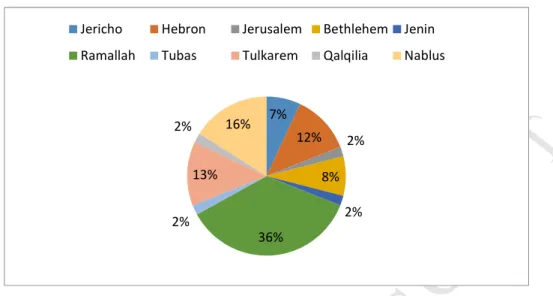
Model development
At the same time, it must ensure that it selects applicants who are sufficiently aware of the importance of the environment to fill vacancies. In the third phase, the manufacturing organization must continue to develop the skills, qualifications and environmental awareness levels of employees by providing green training to the members of the organization and by continuously recording and tracking their performance. Environmental training and development should focus on educating new employees about environmental issues and concerns about the company's green culture by emphasizing these issues during onboarding programs.
On the other hand, in addition to novice workers, experienced workers should also be an essential part of the future analysis of training needs. At this stage, the operationalization of both green training and green performance management and appraisal systems is expected to be considered a priority by the EP. The model suggests that manufacturing organizations could define specific green targets based on the results of performance assessment data.
In the final phase, the production organization should continue to motivate employees and increase their interest in environmental issues through green reward and green employee empowerment. This can be done by linking employee suggestion programs for innovative environmental ideas and solutions to an organizational reward system, where organizations can, using monetary and non-monetary rewards, reward employees for innovative environmental initiative and outstanding EP. The production organization can also provide the opportunity to contribute to EP improvement through employee empowerment and participation.
23 participate in the formulation of environmental strategies to successfully manage and create awareness of the company's environmental issues. Also, organizations can provide employees with opportunities to engage in joint consultations to resolve environmental issues.
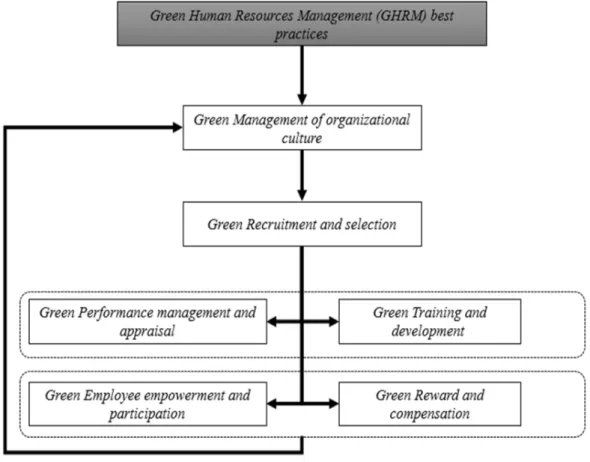
Discussion and conclusion
Thus, it can be said that placing "green management of organizational culture" as the most used GHRM practice introduces it as a priority in the Palestinian manufacturing organizations. However, the second most used practice was the "green performance management and assessment", where respondents agree on the existence of an individual green assessment, recording its results, and predetermining green targets, goals and responsibilities for employees. Although there are very few examples of organizations that have implemented environmental criteria in their recruitment processes in the literature (Jabbour, 2011), the practice of "green recruitment and selection" was the third most used practice in manufacturing organizations.
The results also indicated that "green training and development" was the fourth most used practice impacting EP. This is consistent with the results of Teixeira et al. 2012), who explained that “green training is one of the most important tools for developing human resources and facilitating the transition to a more sustainable society”. Despite this, the results suggest that "green recruitment and selection" is more widely practiced as a tool to attract already qualified and qualified environmental competences in manufacturing organizations; as being more effective and cheaper than organizing formal training courses on environmental issues.
While the need for active involvement of empowered workers in green management has been highlighted in several previous studies (e.g. 2013); Boiral (2009)), this research shows that the GHRM practice of “green employee empowerment and participation” was used at a moderate level. Based on the fact that these methods require more resources, both financial and administrative, to be implemented efficiently, manufacturing organizations are predicted to view green management practices as expensive. 25 Despite the fact that previous studies suggest that rewards and compensation may be useful for GHRM implementation (Daily and Huang, 2001; Govindarajulu and Daily, 2004; Jackson et al., 2011), it is noteworthy that the findings suggest that “ green rewards and compensation” are not widely used within manufacturing organizations to encourage environmentally friendly employee behavior. 2003) explain that it can be difficult to successfully implement a reward system that works for all employees.
Based on the results, it is found that the practices of "green organizational culture management", "green reward and compensation" and "green training and development" are more prevalent among larger organizations than small and medium-sized organizations. The findings also show that the type of industrial sector has a significant effect on the extent of implementation of only "green training and development".
Theoretical and managerial implications
Limitations and future research work
State-of-the-art Green HRM system: sustainability in the sports center in Malaysia using a multi-method approach and possibilities for future research. Environmental management system and HR practices: is there a connection between these in four Brazilian companies? State of the Art and Future Directions for Green Human Resource Management: Introduction to the Special Issue.
Green HRM - Engaging Human Resource in Reducing Carbon Footprint and Improving Environmental Sustainability: A Case Study Based Approach. The moderating effect of 'Green' HRM on the relationship between proactive environmental management and financial performance in small firms. Proceedings of the HR Dialogue, At Department of Human Resource Management and HRM Family, Faculty of Management Studies and Commerce, University of Sri Jayewardenepura, Sri Lanka, Vol.
Assessing Green Human Resources Management Practices in Palestinian Manufacturing Context: An Empirical Study
